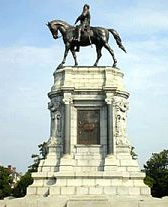 Research for a recent post “Horses of Gettysburg” piqued my curiosity about Robert E. Lee’s mount Traveller, which he purchased as a 4-year-old gelding in 1861. The gray gelding had already distinguished himself at two and three as a blue ribbon-winning saddle horse at the Greenbrier County Fair.
Research for a recent post “Horses of Gettysburg” piqued my curiosity about Robert E. Lee’s mount Traveller, which he purchased as a 4-year-old gelding in 1861. The gray gelding had already distinguished himself at two and three as a blue ribbon-winning saddle horse at the Greenbrier County Fair.
Bred and foaled on the farm of a former sheriff of Greenbrier County, VA, the gray colt, originally named Jeff Davis, was sired by the famous Kentucky racehorse Grey Eagle, who lost a notorious match race in 1839, after being fouled in the stretch by the fleet-footed Louisiana-bred Wagner.
Grey Eagle had set an American record of 3:41 for two miles at Louisville as a three-year-old, but broke down in the third of three four-mile heats against Wagner. The race was a rematch from the previous week, when Wagner won two heats – the second by a neck in a record 7:44.
Although American Saddlebred breeders claim Grey Eagle as a foundation sire, Grey Eagle’s full sister, Falcon was the third dam of Hanover a great Thoroughbred runner and race sire of the late 1880s. Hanover was maternal sire of the first U.S. Triple Crown winner Sir Barton, and paternal sire of the legendary sprinter Pan Zareta.
Traveller wasn’t Lee’s only mount, but he was the horse that Lee rode at the Battle of Gettysburg, and the one he preferred as his personal mount following the war.
Lee had admired the 16-hand gelding, when he was called Greenbrier by the Confederate Army quartermaster who had purchased him from his breeder for $175.00. Undoubtedly conscious of rank, Captain Broun offered the horse to General Lee as a gift, but Lee insisted on paying him $200, and promptly renamed the gelding Traveller.
“He needed neither whip nor spur, and would walk his five or six miles an hour over the rough mountain roads of Western Virginia with his rider sitting firmly in the saddle and holding him in check with a tight rein, such vim and vigor did he manifest to go right ahead so soon as he mounted,” reported Major Thomas L. Broun in the Richmond Dispatch of August 10, 1886.
Traveller’s high spirits cost his new owner considerable discomfort and inconvenience, when he shied and pulled the dismounted general down a steep embankment, causing him to break both hands in the process. While his hands healed, Lee was forced to travel in an army ambulance. When he was able to ride again, it was on a “low, easy-moving, and quiet sorrel mare” given to him by General Jeb Stuart.
Lee rode Lucy Long for two years, until she got in foal in the lines around Petersburg and had to be sent to the rear. From then on, Traveller was Lee’s regular mount. After the war, Lee took the reins as president of Washington College (now Washington and Lee University) in Lexington, VA, where Traveller was allowed to graze on the college lawn and where souvenir seekers often plucked hairs from his mane and tail.
Lee died in 1870. Traveller succumbed to lockjaw in 1871 and was buried on the grounds of Washington and Lee University, not far from the chapel where his former master was interred. Lucy Long died in 1891, at the age of 34 and was buried on the farm of John Mackay.
